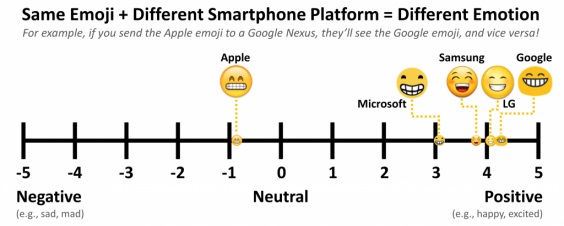
Emojis, those light-hearted, small animated faces that we use to easily communicate emotions and other concepts, are causing confusion among emoji users, according to a recent study. Despite their wide use, the study found that emojis are often lost in translation because different people have vastly different interpretations of some popular emojis.
Researchers from the University of Minnesota, Twin Cities found that the different emoji animation styles of various platforms—Apple, Android, Windows and even Twitter—could be leading to confusion and miscommunication.
As there are at least ten different versions of each emoji in popular use, when someone with an Android device sends a “grinning face with smiling eyes” to someone with an iPhone, the two users will see different variations of the same emoji. As a result, the two users may understand the image in two completely different ways.
The graphic below ranks how misconstrued emojis are across platforms:
“I think some people thought that they could use [emojis] with little risk and what we found is that it actually is at high risk of miscommunication,” Hannah Miller, a Ph.D. student at the University of Minnesota and one of the authors of the study, said in a phone interview.
To accompany the study, titled “Blissfully happy” or “ready to fight”: Varying Interpretations of Emoji, which is set to be officially published at AAAI ICWSM in May, Miller provides an example of emojis styles causing miscommunication.
As part of the study, researchers showed people five different versions of 22 different variations of popular emojis that depict human faces. The participants were then asked to describe the emoji’s meaning and rank it on a scale of “strongly negative to strongly positive.”
“We find that only 4.5 percent of emoji symbols we examined have consistently low variance in their sentiment interpretations,” the researchers write. “Conversely, in 25 percent of the cases where participants rated the same rendering, they did not agree on whether the sentiment was positive, neutral, or negative.”
Here’s how “grinning face with smiling eyes” would look on each platform and how the study’s subjects interpreted it:
The researchers found that for 9 of the 22 tested emojis, the average difference between two platforms was greater than two on its ten-point scale—a huge variation. The ‘grinning face with smiling eyes,’ for instance, is depicted and received very differently by people across different platforms. Google’s depiction—a happy face with a large grin—was ranked at just over 4 out of 5, while Apple’s version of the same emoji was ranked at nearly –1.
However, the confusion is not limited to emoji faces; the study also found that other widely used emojis are also being misinterpreted. For example, the emoji that depicts ‘two hands thrust up into the air’ were received differently across different platforms—the words “stop” and “clap” were used to describe Apple’s version, while the words “praise” and “hand” were used for Google’s version.
However, the emoji miscommunication issue does not stop there, the study also found that people on the same platform often misinterpret the emoji’s meaning.In fact, the researchers found that people using the same platform ranked the emojis 1.88 points apart on the 10 point scale.
Jacob Thebault-Spieker, a PhD student at the University of Minnesota and co-author of the study, suggests that the root of the problem could be that emojis are still a relatively new form of communication.
“The understanding that we have from theory suggests that people build shared meaning of communication and interaction over time,” he said. “These are new. People are building up their new norms within a group of friends or within a geographic region or perhaps even within a culture and those things may start to even out over time.”
You want to support Anonymous Independent & Investigative News? Please, follow us on Twitter: Follow @AnonymousNewsHQ
This Article (Emoji Miscommunication: Study Finds People Interpret Emojis Very Differently) is free and open source. You have permission to republish this article under a Creative Commons license with attribution to the author and AnonHQ.com.







